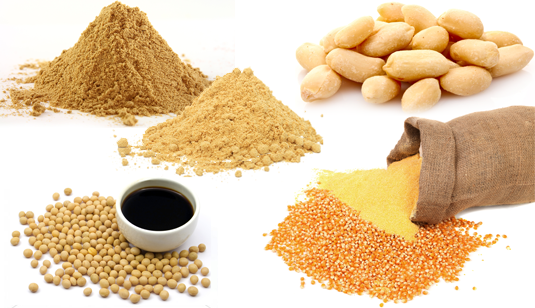
BERITA
Panduan Terbaik untuk Serbuk Protein Sayuran Hidrolisis: Kegunaan, Faedah dan Aplikasi Merentasi Industri
2024-12-20
Serbuk protein sayuran terhidrolisis (HVP) telah menjadi ruji dalam pelbagai industri makanan dan pemakanan kerana pelbagai manfaat kesihatan, serba boleh dan mudah dihadam. Diperbuat daripada sumber berasaskan tumbuhan seperti kacang soya, jagung dan gandum, protein sayuran terhidrolisis digunakan dalam pelbagai aplikasi daripada makanan tambahan kepada penambah rasa makanan dan bahan tambahan makanan haiwan. Memandangkan permintaan pengguna untuk produk berasaskan tumbuhan terus berkembang, penggunaan HVP dalam kedua-dua barangan pengguna dan sektor perindustrian berkembang dengan pesat.
Dalam panduan komprehensif ini, kami akan meneroka semua yang anda perlu tahu tentang serbuk protein sayuran terhidrolisis: ia proses pengeluaran, faedah pemakanan, aplikasi dalam industri yang berbeza, dan sebab mengapa ia telah mendapat populariti sebagai bahan berfungsi dalam banyak produk. Sepanjang perjalanan, kita akan membincangkan peranannya dalam vegan dan diet vegetarian, pemakanan sukan, dan pemprosesan makanan, antara lain.

1. Apakah Serbuk Protein Sayuran Hidrolisis?
Serbuk protein sayuran terhidrolisis (HVP) adalah sejenis protein sayuran yang telah dipecahkan kepada peptida dan asid amino yang lebih kecil melalui proses yang dipanggil hidrolisis. Proses ini melibatkan penggunaan air dan kadangkala haba atau enzim untuk "memecahkan" protein kepada bentuk yang lebih mudah dihadam, menjadikannya lebih mudah untuk diserap oleh tubuh manusia.
Bentuk protein ini diperoleh daripada pelbagai sumber tumbuhan, termasuk kacang soya, gandum, dan jagung, yang kaya dengan asid amino penting untuk kesihatan manusia. Proses hidrolisis meningkatkan keterlarutan dan kebolehcernaan protein, itulah sebabnya ia sering digunakan dalam produk yang memerlukan penyerapan cepat.
Kata Kunci Dikembangkan:
- Protein tumbuhan terhidrolisis
- Serbuk protein berasaskan tumbuhan
- Pencernaan HVP
- Asid amino daripada sayur-sayuran
| Sumber Protein | Kaedah Hidrolisis | Asid Amino Dihasilkan |
|---|---|---|
| soya | Hidrolisis enzimatik | Leucine, Isoleucine, Valine |
| Gandum | Hidrolisis berasid | Glutamin, Lysine, Proline |
| jagung | Hidrolisis enzimatik atau berasid | Arginine, Serine, Threonine |
2. Proses Hidrolisis: Bagaimana HVP Dihasilkan
Pengeluaran protein sayuran terhidrolisis melibatkan penguraian protein kompleks kepada asid amino konstituen dan peptida yang lebih kecil. Proses ini bukan sahaja meningkatkan bioavailabiliti protein tetapi juga meningkatkan sifat fungsinya, seperti keterlarutan dan pengemulsi.
2.1. Hidrolisis enzimatik
Hidrolisis enzimatik melibatkan penggunaan enzim khusus untuk memecahkan molekul protein kepada komponen yang lebih kecil. Kaedah ini sering diutamakan kerana keupayaannya menghasilkan protein yang berkualiti tinggi dan mudah dihadam tanpa menggunakan bahan kimia yang keras. Ia amat berkesan untuk protein berasaskan tumbuhan seperti soya dan protein kacang.
2.2. Hidrolisis berasid
Hidrolisis asid ialah kaedah yang lebih mudah yang menggunakan asid, seperti asid hidroklorik, untuk memecahkan molekul protein. Walaupun proses ini lebih pantas dan lebih menjimatkan kos, ia kadangkala boleh menghasilkan rasa yang lebih pahit, itulah sebabnya hidrolisis enzimatik sering diutamakan untuk produk gred makanan.
2.3. Keadaan dan Kawalan Hidrolisis
Mengawal keadaan hidrolisis (seperti suhu, masa, tahap pH) adalah penting untuk mendapatkan sifat protein yang dikehendaki. Sebagai contoh, suhu yang lebih rendah boleh mengekalkan rasa, manakala suhu yang lebih tinggi mungkin mempercepatkan proses hidrolisis tetapi boleh mengubah rasa dan aroma produk akhir.
3. Faedah Pemakanan Serbuk Protein Sayuran Hidrolisis
Serbuk protein sayuran terhidrolisis menawarkan beberapa manfaat pemakanan, menjadikannya pilihan popular untuk pelbagai keperluan diet. Berikut adalah beberapa sebab HVP digemari sebagai sumber protein:
3.1. Bioavailabiliti tinggi
Faedah utama protein sayuran terhidrolisis ialah bioavailabilitinya yang tinggi. Disebabkan oleh proses hidrolisis, protein dipecahkan kepada peptida dan asid amino, yang lebih mudah untuk diserap dan digunakan oleh sistem pencernaan. Ini amat bermanfaat untuk individu yang mempunyai masalah pencernaan atau mereka yang memerlukan penyerapan protein yang cepat, seperti atlet atau orang yang pulih daripada pembedahan.
Kata Kunci Dikembangkan:
- Sumber protein yang boleh dihadam
- Protein yang cepat menyerap
- Profil asid amino
3.2. Profil Protein Lengkap
HVP mengandungi a profil protein lengkap, bermakna ia membekalkan kesemua sembilan asid amino penting yang tidak dapat dihasilkan oleh tubuh manusia sendiri. Ini menjadikannya alternatif yang sangat baik untuk protein berasaskan haiwan, terutamanya untuk individu diet berasaskan tumbuhan atau mereka yang mempunyai vegan atau vegetarian keutamaan.
Kata Kunci Berkaitan:
- Protein vegan
- Asid amino penting
- Protein tumbuhan yang lengkap
3.3. Alergenik yang rendah
Tidak seperti beberapa bentuk protein lain, seperti whey atau kasein, protein sayuran terhidrolisis biasanya rendah alergen, menjadikannya sesuai untuk orang yang mempunyai intoleransi laktosa, kepekaan gluten atau alahan tenusu. HVP boleh diperoleh daripada sumber bebas gluten seperti soya atau kacang polong, yang meluaskan lagi daya tarikannya ke pasaran yang lebih luas.
Kata Kunci Dikembangkan:
- Protein bukan tenusu
- Serbuk protein bebas gluten
- Protein hipoalergenik
4. Penggunaan Serbuk Protein Sayuran Hidrolisis
Serbuk protein sayuran terhidrolisis digunakan dalam pelbagai industri, daripada makanan dan minuman kepada kosmetik dan farmaseutikal. Di bawah, kami akan meneroka sektor utama yang HVP memainkan peranan penting.
4.1. Industri Makanan dan Minuman
Dalam industri makanan dan minuman, protein sayuran terhidrolisis sering digunakan sebagai a penambah rasa. Disebabkan olehnya umami rasa, ia biasanya dimasukkan ke dalam sup, sos, dan makanan ringan untuk meningkatkan rasa tanpa memerlukan garam tambahan atau bahan tambahan tiruan.
| Jenis Produk | Penggunaan HVP | Faedah |
|---|---|---|
| Sup & Sup | Meningkatkan rasa pedas | Mengurangkan natrium, menambah rasa |
| Alternatif Daging | Memberi tekstur dan rasa | Meniru rasa umami daging |
| Snek Diproses | Penambah rasa | Meningkatkan kelazatan |
4.2. Diet Vegan dan Vegetarian
Sebagai permintaan untuk produk berasaskan tumbuhan meningkat, protein sayuran terhidrolisis memainkan peranan penting dalam membangunkan alternatif daging dan serbuk protein berasaskan tumbuhan. HVP menyediakan sumber protein yang berkualiti tinggi dan mudah dihadam bagi mereka yang mengikuti a vegan atau vegetarian gaya hidup.
Kata Kunci Berkaitan:
- Daging berasaskan tumbuhan
- Serbuk protein vegan
- Protein pengganti daging
4.3. Pemakanan Sukan
Serbuk protein sayuran terhidrolisis juga popular di pemakanan sukan industri. Atlet dan peminat kecergasan menggunakannya untuk pembaikan dan pemulihan otot. Penyerapan pantas dan profil asid amino yang lengkap menjadikannya pilihan terbaik untuk pemakanan selepas bersenam.
Kata Kunci Dikembangkan:
- Protein selepas bersenam
- Protein pemulihan otot
- Tambahan protein sukan
4.4. Makanan Haiwan
HVP juga digunakan dalam makanan haiwan, terutamanya untuk ternakan dan ayam itik. Ia membantu menyediakan protein berkualiti tinggi dan mudah dihadam untuk haiwan, meningkatkan kadar pertumbuhan dan kesihatan keseluruhannya.
Kata Kunci Berkaitan:
- Tambahan protein haiwan
- Protein makanan ternakan
- Makanan ayam
4.5. Kosmetik dan Penjagaan Kulit
Protein sayuran terhidrolisis mempunyai aplikasi di luar makanan. Ia kadangkala digunakan dalam formulasi kosmetik untuk menguatkan rambut dan meningkatkan keanjalan kulit. HVP terkenal dengan keupayaannya untuk menembusi batang rambut, memberikan penghidratan dan khasiat.
Kata Kunci Dikembangkan:
- Protein untuk penjagaan rambut
- Protein penjagaan kulit
- Protein terhidrolisis dalam kosmetik
5. Mengapa Memilih Serbuk Protein Sayuran Hidrolisis?
Serbuk protein sayuran terhidrolisis menawarkan beberapa kelebihan berbeza berbanding sumber protein lain. Kebolehcernaan, profil pemakanan dan serba boleh menjadikannya pilihan ideal untuk orang yang mempunyai keperluan diet khusus atau mereka yang mencari alternatif berasaskan tumbuhan.
5.1. Mampan dan Beretika
Sebagai sumber protein berasaskan tumbuhan, HVP lebih mampan daripada protein yang berasal dari haiwan, memerlukan lebih sedikit sumber (tanah, air dan tenaga) untuk dihasilkan. Selain itu, ia menarik kepada pengguna beretika yang lebih suka produk vegan atau bebas kekejaman.
Kata Kunci Berkaitan:
- Protein yang mampan
- Penyumberan protein beretika
- Kelestarian berasaskan tumbuhan
5.2. Mampu Milik dan Kos-Efektif
HVP selalunya lebih berpatutan daripada protein berasaskan haiwan, yang menjadikannya pilihan yang menarik bagi pengeluar yang ingin mengurangkan kos pengeluaran sambil masih menawarkan protein berkualiti tinggi dalam produk mereka.
Kata Kunci Dikembangkan:
- Protein mampu milik
- Bahan protein yang menjimatkan kos
- Perbandingan harga protein
6. Kesimpulan
Serbuk protein sayuran terhidrolisis adalah ramuan serba boleh dan bermanfaat yang mempunyai aplikasi meluas dalam pelbagai industri. Daripada meningkatkan rasa produk makanan kepada menyediakan sumber protein berkualiti tinggi untuk atlet dan vegan, HVP terus berkembang popular.
Sama ada anda sedang mencari pilihan protein yang mampan, ramuan untuk penambah rasa, atau penyelesaian untuk sekatan diet, serbuk protein sayuran terhidrolisis menawarkan pelbagai manfaat.
Halaman sebelumnya:Memahami Protein Sayuran Hidrolisis vs MSG: Perbezaan Utama dan Implikasi Kesihatan
Muka surat seterusnya:Panduan Komprehensif untuk Proses Pengilangan Protein Sayuran Hidrolisis

